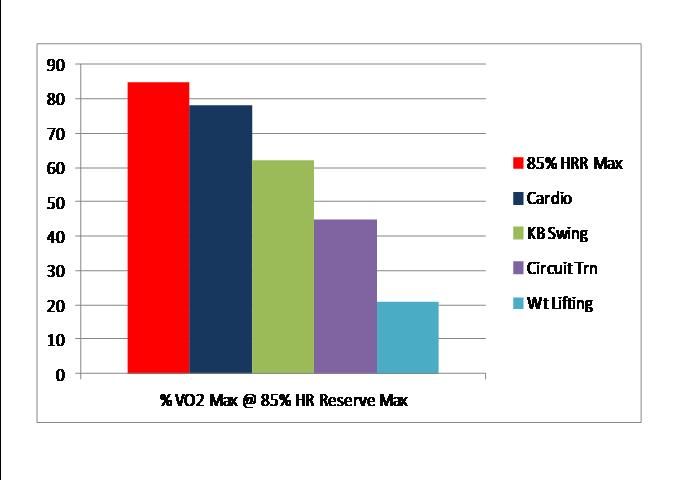THIS is why HRMs have limited use for tracking calories
Options
Replies
-
Why not just use the 'average heart rate' and calculate the calories yourself? I find that when I do that, my calculated calories are quite a bit lower than what the HRM calculates.
The formula that I use is (note, for women):
Calories Burned = [(Age x 0.074) -- (Weight x 0.05741) + (Heart Rate x 0.4472) -- 20.4022] x Time / 4.184.
For men:
Calories Burned = [(Age x 0.2017) + (Weight x 0.09036) + (Heart Rate x 0.6309) -- 55.0969] x Time / 4.184.
Those have a built in assumption of VO2max, based on weight and age.
The other version of the formulas the Polar funded study came up with includes a VO2 stat. But then you must get that with some reasonable estimate.
http://www.braydenwm.com/calburn.htm
But then what is left out that other studies have shown is beneficial, is the known HRmax stat. Otherwise, again the formula is assuming 220-age (which they get), and then about 85% of that is lactate threshold, which is assumed to be a certain % of VO2max.
Bunch of assumptions that can be true for population groups, difficult to get down to individual level.
Though I did tweak their formula to account for a different HRmax than assumed, in case you had better estimate or tested.
Azdak would love to run around with a metabolic cart testing someone. Forget the treadmill, he's fast enough to push it around the track now!
Now, where's my calorie burn....0 -
must admit I find it annoying that it keeps telling me each week that I need to take a recovery week but I am training for events so have to hit it hard. I haven't even used the strength training programme built in yet (which may be useless anyway by the indications here lol)
For it to get to the point of recommending a whole week, that must mean you are taking no recovery days.
May want to rethink that approach, as it's the easy day that allows recovery to get stronger from the harder workout.
Exercise tears down. It's the rest for recovery and repair that builds back up.
You might be surprised how much progress you can still make not going full-tilt every day.0 -
must admit I find it annoying that it keeps telling me each week that I need to take a recovery week but I am training for events so have to hit it hard. I haven't even used the strength training programme built in yet (which may be useless anyway by the indications here lol)
For it to get to the point of recommending a whole week, that must mean you are taking no recovery days.
May want to rethink that approach, as it's the easy day that allows recovery to get stronger from the harder workout.
Exercise tears down. It's the rest for recovery and repair that builds back up.
You might be surprised how much progress you can still make not going full-tilt every day.
I think the recovery week is an automatic built in thing as it just popped up at the beginning of a week's targets. I do have rest days - it is the FT80 I have and it sets 3 different levels of intensity each week working in low, moderate and high heart rates with calorie and time targets. I am training for climbing Ben Nevis in just over 2 weeks then have Tough Mudder in 5 weeks so I am doing a real mix of training from walking, hiking, hill/mountain climbing mostly at the weekends and the Tough Mudder bootcamp a couple of days a week and an upper body strength/weights programme 2 to 3 days a week - I typically have one or two rest days a week - but I am finding that even one TM bootcamp is enough to max out the high intensity target - so each week it tells me to take a rest week - it still has targets for medium and low sessions but I am not supposed to do any high intensity. - just doing the stair climber for 25 mins - (which is good prep for mountain climbing) will max it out.
@ Azdak - I know you are not saying HRM's are useless - just that they are not gospel and the data derived from them is all relative (well that is how I am interpreting it anyway lol) it has indicated with no doubt that my resting heart rate has greatly improved and as soon as I stop pushing myself it drops like a stone - which I think is a better indication of fitness I wouldn't be aware of if I wasn't using one.0 -
i actually went to UPMC in the southside of pittsburgh (steelers training facility) to have my Body Fat and my bmr tested
i use that information as my base readins
i think i might be the only person that finds MFP calorie burn estimation to be greatly exaggerated compared to my HRM.
if i did an hour on the elliptical the machine said 700 cals burned, MFP said 956 and my HRM was at about 450.
right now im eating 1700 a day (actually just a smidge under). i do 30 minutes on the arc trainer (510/HR according to my HRM), do my workout (1 body part per weekday) then do 30-45 minutes swimming (logged at 150 cals burned)
unless i have an actual machine attached to me at all time i think you really have to go with the low end of estimates rather than rely on MFP for your cals burned0 -
Ok, so in view of the criticism raised, your suggestion, Azdak, is to estimate a caloric value that might be x % less than TDEE, and tweak as we go, and forget about logging/'eating back' calories. Makes sense, I am fine with that, thank you!
If calories burned isn't helpful for tracking workouts (which I guess people want to do), what do you think about using rate of perceived exertion (or "intensity"), and time?
Seems to me that if you work bloody hard for 40 minutes, it'll add up to something.0 -
Thanks so much for posting this, this is really useful.0
-
This whole thread makes me sad. Here I've been feeling so great about logging those exercise calories... I guess the positive is that I never eat them back and I'm losing weight.
I also feel really dumb because I'm a RN with 20 years of experience and when I read this stuff all I hear is "Blah blah blah I need some new shoes..."
My question is - if I'm doing a exercise, let's say a FitnessBlender routine with kettlebells, and the routine lasts 30 minutes, and at the end of it I'm a soaking wet sweat mess and completely out of breath, what percentage of the 460 calories it says I burned do I log? Or should I?
Thanks for the advice and the discussion!0 -
-
I use my HRM for all of my exercise. I eat at my calorie goal 6 days a week and then I have an open day. Sometimes I go over big time and sometimes not on the open day. I understand what is being said here, but I will continue to use my HRM. Most of my exercise is cardio 6 days a week and I do strength training at least 4 days a week. I have lost 141 lbs since I started and I think I will continue to count weight lifting calories burnt. This is making it too complicated. As an earlier poster said eat right and move and you will have success. Thanks for the post.0
-
This whole thread makes me sad. Here I've been feeling so great about logging those exercise calories... I guess the positive is that I never eat them back and I'm losing weight.
I also feel really dumb because I'm a RN with 20 years of experience and when I read this stuff all I hear is "Blah blah blah I need some new shoes..."
My question is - if I'm doing a exercise, let's say a FitnessBlender routine with kettlebells, and the routine lasts 30 minutes, and at the end of it I'm a soaking wet sweat mess and completely out of breath, what percentage of the 460 calories it says I burned do I log? Or should I?
Thanks for the advice and the discussion!
Well, if you don't eat back exercise calories the way MFP is designed, and creating an even bigger deficit and losing muscle mass, then it really doesn't need to be logged except for your record keeping.
Doesn't sound like you'll let it influence the eating goal anyway. So you can make it whatever you want.
And most people could run up stairs and be out of breath, heart pounding, and sweating in probably as little as 2 minutes, so don't let that fool ya too much. Anaerobic exercise must be caught up with eventually.0 -
BUMP0
-
This whole thread makes me sad. Here I've been feeling so great about logging those exercise calories... I guess the positive is that I never eat them back and I'm losing weight.
I also feel really dumb because I'm a RN with 20 years of experience and when I read this stuff all I hear is "Blah blah blah I need some new shoes..."
My question is - if I'm doing a exercise, let's say a FitnessBlender routine with kettlebells, and the routine lasts 30 minutes, and at the end of it I'm a soaking wet sweat mess and completely out of breath, what percentage of the 460 calories it says I burned do I log? Or should I?
Thanks for the advice and the discussion!
Well, if you don't eat back exercise calories the way MFP is designed, and creating an even bigger deficit and losing muscle mass, then it really doesn't need to be logged except for your record keeping.
Doesn't sound like you'll let it influence the eating goal anyway. So you can make it whatever you want.
And most people could run up stairs and be out of breath, heart pounding, and sweating in probably as little as 2 minutes, so don't let that fool ya too much. Anaerobic exercise must be caught up with eventually.
My muscle mass is building up quite nicely, thanks!0 -
I'm sorry but this just confused the hell out of me. So are you saying I shouldn't use the calories burned that my HRM shows when tracking exercise.
Depends on the exercise. The OP states: <SNIP>The entire concept of using heart rate as means of estimating exercise calories is based on the relationship between heart rate (HR) and oxygen uptake (VO2) during steady-state aerobic exercise.
During steady-state aerobic exercise, there is a relatively consistent relationship between HR and VO2.
Visualize a car equipped with a tachometer. Cruising at a constant speed on the open highway one could more accurately estimate fuel expenditure per mile merely by monitoring the tach.
Not so in city driving because of inconsistent demands on the power plant. (do I make sense or do I only think I do? LOL)
I think this is a good analogy 0
0 -
Your HRM's manual will say it's meant only for steady state cardio because HRMs use a formula made specifically for those exercises and those exercises only.
So if you look at the chart, you'll see that using a HRM for anything will give you a falsely elevated calorie burn. I wear mine during weight lifting (because I use it for my warm up and to do cardio afterward) and it will easily tell me I burned 400 cals in 30 minutes, when the reality is I probably burned 100 or less.
My Polar RCX3 has options for biking/running and other. Whenever I go to the gym to lift weights, I hardly burn any calories. Last night it was something like 25 in a 15-20 min session. Then I switched to the row machine, then onto the bike and burned a reasonable amount (but much less than what the machines themselves said).
I have not found the Polar to be far off. If anything, it is always lower than either MFP or whatever is built into the machine I am working on.0 -
bump to read later0
-
My Polar RCX3 has options for biking/running and other. Whenever I go to the gym to lift weights, I hardly burn any calories. Last night it was something like 25 in a 15-20 min session. Then I switched to the row machine, then onto the bike and burned a reasonable amount (but much less than what the machines themselves said).
I have not found the Polar to be far off. If anything, it is always lower than either MFP or whatever is built into the machine I am working on.
Do you update the VO2max stat on there after changing weight loss on the device?
Merely losing weight but keeping the same fitness level actually raises VO2max stat.
Polar's FAQ also says do the test first thing in morning after a rest day, otherwise you can mess up the analysis, which is mostly just getting the restingHR, but still.
If the HRM had an old VO2max stat, which is lower than current real value, it'll see low HR as low effort as low calorie burn, which is not correct.
Because rowers and bikes with electric resistance aren't too bad, it usually knows the watts expended, and watts is energy, and converts to calories.
Of course for both of those, personal efficiency can have a decent impact, compared to walking or slower jogging that has much less variance.0 -
Really good post.
Trying to futilely estimate calorie burns was frustrating for me anyway, so I'm glad I'm sticking with the TDEE - 20% method. I'm really glad you brought this up though. It was a really eye-opening read.0 -
good info! I am going to finish reading through this tomorrow.0
-
The entire concept of using heart rate as means of estimating exercise calories is based on the relationship between heart rate (HR) and oxygen uptake (VO2) during steady-state aerobic exercise.
During steady-state aerobic exercise, there is a relatively consistent relationship between HR and VO2. Working at "X%" of HRmax usually means that one is working at "Y%" of VO2 max. If you know your VO2max and your true HRmax, then you can use that relationship to estimate VO2 during exercise--which means that you can also estimate calories, since calories burned is based on VO2 times body weight.
Once you leave the realm of steady-state aerobic exercise, however, accuracy of HRMs deteriorates rapidly. To understand why, you need to look at this chart:
The chart shows the percentage of VO2max that occurs when heart rate is at 85% of max HR reserve during various activities.
As you can see, it's quite a spread. The red bar is the heart rate--here, set at 85% max HR reserve. The blue bar is steady-state cardio. As you can see, steady-state cardio is the closest match.
While a heart rate of 85% of max corresponds to 75%-80% VO2 max during steady-state cardio, by the time you get to lifting heavy weights, that same heart rate of 85% of max corresponds to only 21% of VO2max.
The HRM doesn't know the difference--it is programmed to display a calorie number based on whatever heart rate it senses. It cannot detect the type of activity. This is why HRM calorie numbers for many non-steady-state-aerobic activities are useless.
The same situation is also true during thermal stress. Heart rate is elevated, while VO2 is not. That's why the inflated calorie claims for activities such as hot yoga are such nonsense.
For some reason, even though this is exercise physiology 101, many so-called "fitness experts" do not understand this. Now that you do, this is one way to evaluate the credibility of a trainer or fitness author. If they say something like "lifting weights can be cardio if you move quickly between exercises to keep your heart rate up", you know you are listening to someone with a serious deficit in their knowledge base--and you'll have to wonder what else they don't know.0 -
So if an HRM isn't good for interval training, isn't good for lifting weights, and is only good for steady state cardio, then what's the purpose of using one? I thought about getting one but now I'm reconsidering.
I currently jog for 3 minutes and walk for 2 for 2 miles....building up for a continuous run of the whole 2 miles. I also do P90X Lean schedule on alternate days of running. Will an HRM work for calculating calories for this or do these 2 types of exercise fall into the ones that render it useless?0
Categories
- All Categories
- 1.4M Health, Wellness and Goals
- 391.9K Introduce Yourself
- 43.5K Getting Started
- 259.8K Health and Weight Loss
- 175.7K Food and Nutrition
- 47.3K Recipes
- 232.3K Fitness and Exercise
- 396 Sleep, Mindfulness and Overall Wellness
- 6.4K Goal: Maintaining Weight
- 8.5K Goal: Gaining Weight and Body Building
- 152.8K Motivation and Support
- 7.9K Challenges
- 1.3K Debate Club
- 96.3K Chit-Chat
- 2.5K Fun and Games
- 3.3K MyFitnessPal Information
- 23 News and Announcements
- 972 Feature Suggestions and Ideas
- 2.3K MyFitnessPal Tech Support Questions














